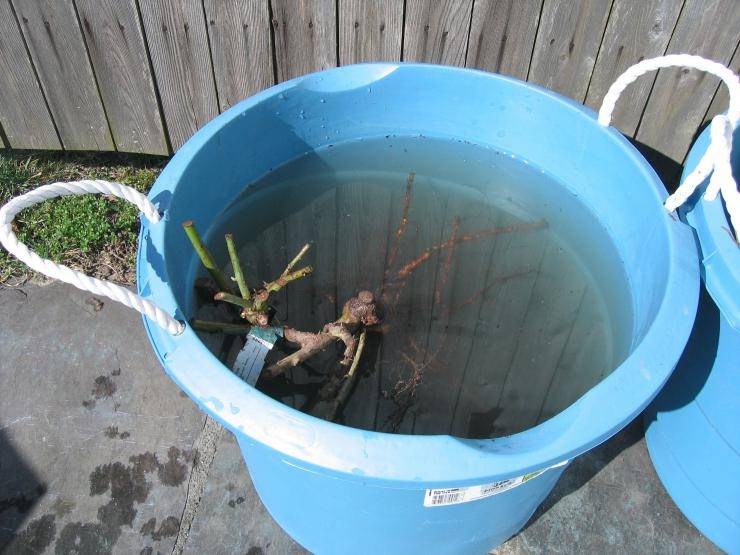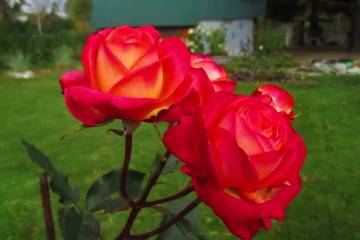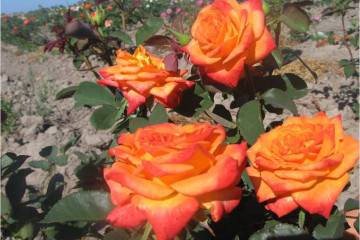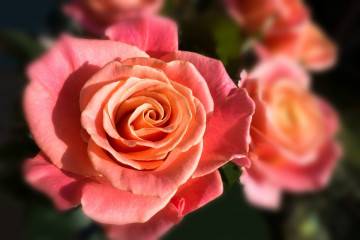Rose Florentina (Florentina) - what is this unique variety
Content:
Rose Florentina is very popular with gardeners. This climbing culture can wind through various structures. It has long shoots and rich red flowers. The culture is grown in the form of bushes or on a trunk.
Rose Florentina (Florentina) - what kind of variety, history of creation
This horticultural crop was bred in the German nursery Kordes. The plant has become widespread throughout the world, since it has many advantages. It is sometimes called the rose of Florence.
The culture is characterized by double inflorescences with dense petals. The buds reach 11 cm in diameter. They have a rich red hue and a yellow center. The buds do not fade in the sun. After the rain, stains do not appear on their petals. Flowering is quite abundant and lasts until September.
In height, the bushes of the climbing rose Florentina reach 2 m.Taller plants are also found, so they need to be cut periodically. The culture has very thick and strong stems, as well as dense foliage.
Advantages and disadvantages of the variety
The key plant benefits include the following:
- unpretentious care;
- excellent frost tolerance;
- resistance to black spot;
- rich color of buds;
- a large number of flowers on the bushes.
In the description of the rose, certain disadvantages are also indicated:
- weak aroma;
- the need to fix shoots;
- impaired growth in cold weather.
Use in landscape design
The plant can be used for single plantings or planted in groups to decorate borders. The culture can be placed in open spaces or cascades. The rose looks spectacular when grown on a trunk.
Growing a flower in the open field
To achieve a spectacular rose, it must be planted correctly. It is recommended to plant seedlings in the fall a month before frost. If planting is planned in the spring, then you need to wait until the soil warms up to +10 degrees.
The culture is considered quite demanding in terms of site selection. Therefore, a suitable place must be prepared in advance. It should be well lit and ventilated. In this case, drafts are unacceptable.
How to prepare the soil and flower for planting
The plant needs loamy soil or black soil. It should be slightly acidic. With low acidity parameters, manure or peat can be added to the soil. If the soil is too acidic, use lime or wood ash.
With the selection of the required site and the correct preparation of the soil, planting work can begin. Beforehand, the roots of the seedlings should be immersed in water for several hours. This will help speed up adaptation to new conditions. It is also permissible to soak the plant in a growth stimulator for several hours.
Planting procedure step by step
To plant a culture, you should follow these recommendations:
- Make a 60 cm depression.
- Place stones or rubble at the bottom. The drainage layer must be 10 cm thick.
- Apply fertilizer to the soil.Usually rotted manure or compost is used for this purpose.
- Plant a bush. In this case, it is important to ensure that the root collar is deepened by 3 cm.
- Compact the soil around the seedling and water it well.
- Cover the trunk circle with a mulch layer. You can use peat for this.
Plant care
For a culture to develop fully, it needs to be provided with adequate and quality care. This is, first of all, watering. To do this, use warm water, best of all, settled. Water the rose 2 times a week. This should be done using the sprinkler method. With heavy rainfall, watering should be reduced. In dry weather, the amount of soil moisture, on the contrary, should be increased. 1 bush requires 1 bucket of water.
In the spring, the plant needs to be fed with a nitrogen mixture. In summer, you should use soluble minerals - potassium, calcium, phosphorus.
Sanitary pruning should be carried out in the spring after swelling of the buds. In this case, you need to get rid of old and frozen shoots. For abundant flowering on the branches, you need to leave 5-7 buds. In the summer, wilted buds should be removed. Before winter arrives, formative pruning should be done.
Features of wintering a flower
In areas where there is no severe frost and a large amount of snow falls, there is no need to make temporary shelters. In temperate latitudes, shoots must be removed from the supports and laid on supports. Cover the top with dry branches or spruce branches. Bushes that are grown on a trunk should be covered with a thick film.
Blooming rose
The plant is characterized by double inflorescences. Flowering begins in June and lasts until September with short rest periods, which do not exceed 3-5 days.
At the stage of rapid flowering, the plant needs fertilization. They need to be added to water in a 1: 5 ratio. After flowering is complete, you need to cut off all the buds, reduce the amount of watering and loosen the soil.
What to do if it does not bloom
The lack of flowering can be due to such factors:
- freezing of flower buds;
- alkaline soil;
- exposure to direct sunlight;
- lack of moisture.
Flower propagation
A climbing rose can be propagated by cuttings, layering, dividing a bush, by seed or budding.
The most popular way of plant propagation is cuttings. Planting material should be harvested from adult bushes after the completion of the first wave of budding.
Remove all leaves from the cuttings, split the lower part of the stem and soak it in a growth stimulator for 2 hours. After that, the plant must be planted in the ground. In this state, the cuttings will take root within 2 months.
Diseases, pests and ways to control them
The culture is characterized by average immunity. With a pronounced contrast of temperatures day and night, gray rot or rust develops on the rose. If there is high humidity and air temperature, there is a risk of powdery mildew. To avoid such problems, the rose is sprayed with fungicides.
Of the parasites, the rose can suffer from attacks by rose sawflies and aphids. Insecticides will help to cope with pests. If spider mites appear on the plant, it is recommended to use acaricides.
Florentina rose is easy to care for. It is characterized by abundant flowering and active development.To use a plant for garden decoration, you need to plant it correctly and prune the bushes in a timely manner. Protection of crops from diseases and pests is of no small importance.




















